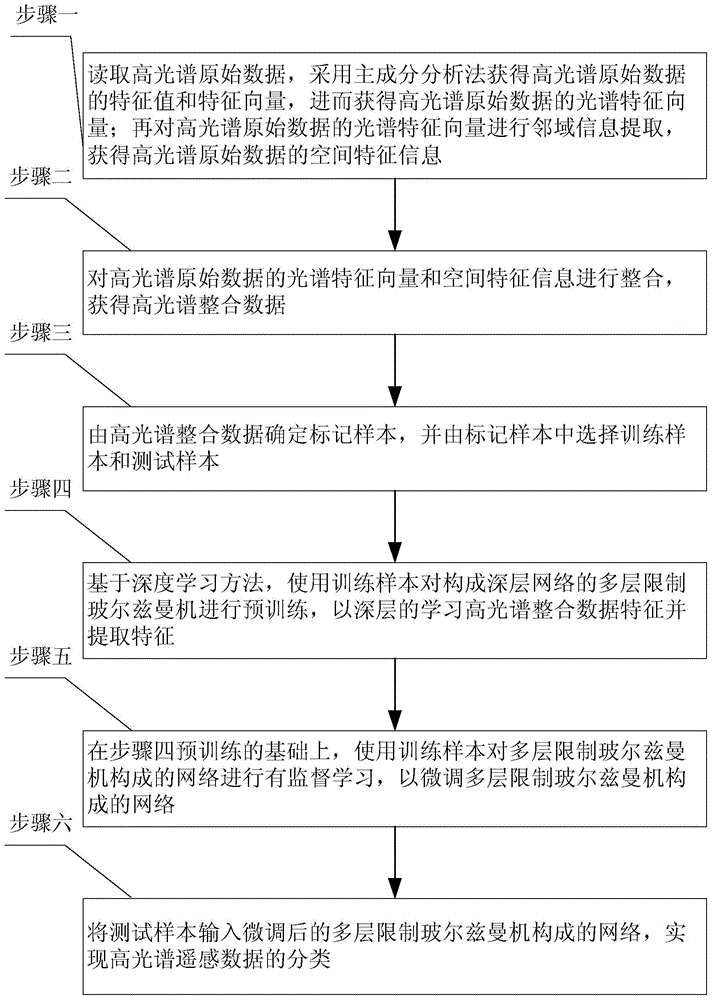Hyperspectral remote sensing data classification method based on deep learning
A hyperspectral remote sensing and deep learning technology, applied in the field of hyperspectral data classification, can solve the problem of low classification accuracy, achieve accurate data classification and reduce the effect of impact
- Summary
- Abstract
- Description
- Claims
- Application Information
AI Technical Summary
Problems solved by technology
Method used
Image
Examples
specific Embodiment approach 1
[0033] Specific embodiment one: the following combination figure 1 Describe this embodiment, the deep learning-based hyperspectral remote sensing data classification method described in this embodiment, which includes the following steps:
[0034] Step 1: Read the hyperspectral raw data, use the principal component analysis method to obtain the eigenvalues and eigenvectors of the hyperspectral raw data, and then obtain the spectral eigenvectors of the hyperspectral raw data; Domain information extraction to obtain spatial feature information of hyperspectral raw data;
[0035] Step 2: Integrate the spectral feature vector and spatial feature information of the original hyperspectral data to obtain integrated hyperspectral data;
[0036] Step 3: Determine the labeled samples from the hyperspectral integration data, and select training samples and test samples from the labeled samples;
[0037] Step 4: Based on the deep learning method, use the training samples to pre-train ...
specific Embodiment approach 2
[0040] Embodiment 2: This embodiment further describes Embodiment 1, and the method for obtaining the spectral feature vector of the hyperspectral raw data is as follows:
[0041] First, the covariance matrix of the hyperspectral raw data is calculated, and the eigenvalues and eigenvectors of all hyperspectral raw data are calculated and obtained by principal component analysis according to the covariance matrix, and the corresponding features are arranged in the order of eigenvalues from large to small. vector; use the eigenvectors as the weighting coefficient to obtain the B-band principal component components of all eigenvectors, and use all the eigenvectors containing the B-band principal component components as the spectral eigenvectors of the hyperspectral raw data; B is a positive integer;
[0042] The method of obtaining the spatial feature information of the hyperspectral raw data is as follows:
[0043] Select the first N principal component components in the B b...
specific Embodiment approach 3
[0047] Embodiment 3: This embodiment further describes Embodiment 2, and the specific method for obtaining hyperspectral integration data is: i , y i ) spectral information is regarded as a spectral feature vector of length B, and all the pixel points (x i , y i ), a spectral eigenvector of length B and a length of N×w 2 The spatial feature information of , integrated into a length of (B+N×w 2 ) vector, as the hyperspectral integration data.
[0048] In this embodiment, in the hyperspectral data after information integration, each pixel will have a length of (B+N×w containing spectral information and spatial information) 2 ) feature vector.
PUM
 Login to View More
Login to View More Abstract
Description
Claims
Application Information
 Login to View More
Login to View More - R&D
- Intellectual Property
- Life Sciences
- Materials
- Tech Scout
- Unparalleled Data Quality
- Higher Quality Content
- 60% Fewer Hallucinations
Browse by: Latest US Patents, China's latest patents, Technical Efficacy Thesaurus, Application Domain, Technology Topic, Popular Technical Reports.
© 2025 PatSnap. All rights reserved.Legal|Privacy policy|Modern Slavery Act Transparency Statement|Sitemap|About US| Contact US: help@patsnap.com

